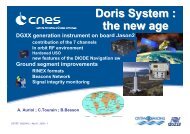IDS activity report 2011 - International DORIS Service
IDS activity report 2011 - International DORIS Service
IDS activity report 2011 - International DORIS Service
Create successful ePaper yourself
Turn your PDF publications into a flip-book with our unique Google optimized e-Paper software.
1 INTRODUCTIONAs other space-techniques had already organized into services - the <strong>International</strong> GNSS<strong>Service</strong> (IGS) for GPS, GLONASS and, in the future, Galileo (Beutler et al. 1999), the<strong>International</strong> Laser Ranging <strong>Service</strong> (ILRS) for both satellite laser ranging and lunar laserranging (Pearlman et al. 2002) and the <strong>International</strong> VLBI <strong>Service</strong> for Geodesy andAstrometry (IVS) for geodetic radio-interferometry (Schlueter et al. 2002) -, the <strong>IDS</strong> wascreated in 2003 as an IAG service to federate the research and developments related to the<strong>DORIS</strong> technique, to organize the expected <strong>DORIS</strong> contribution to IERS and GGOS(Rummel et al. 2005; Willis et al. 2005), and to foster a larger international cooperation onthis topic.At present, more than 50 groups from 35 different countries participate in the <strong>IDS</strong> at variouslevels, including 43 groups hosting <strong>DORIS</strong> stations in 32 countries all around the globe.Two analysis centers contributed as individual <strong>DORIS</strong> solutions to ITRF2005 and in 2006four analysis centers provided results for <strong>IDS</strong>. Since 2008, eight analysis groups haveprovided results, such as orbit solutions, weekly or monthly station coordinates, geocentervariations or Earth polar motion, that are used to generate <strong>IDS</strong> combined products for geodesyor geodynamics. All these centers have provided SINEX solutions for inclusion in the <strong>IDS</strong>combined solution that was submitted in 2009 to the IERS for ITRF2008. In 2009, a first <strong>IDS</strong>combined solution (Valette et al., 2010) was realized using <strong>DORIS</strong> solutions from 7 AnalysisGroups for weekly station positions and daily Earth orientation parameters.15






